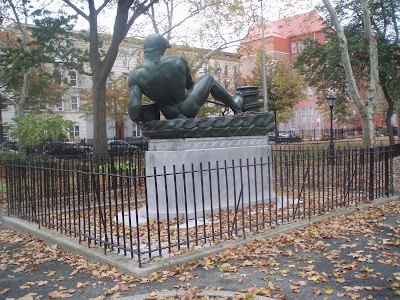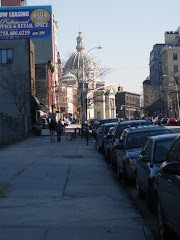Several things crashed together in my brain recently and resulted in this posting. First, during my wandering around Bushwick this past summer, I came across a couple of well cared for war memorials dating back to the First World War. Either I don’t notice those things when I pass by them, or there aren’t that many to begin with and it was just coincidental that I should happen on two within several blocks of each other around the same time. In any case, it spiked my curiosity about whether there were others around
The second object in the brain collision was a story that was covered in the New York Times around that same time about a cross used as memorial in the Mojave National Preserve in
The Constitution and the Cross
Religion Largely Absent in Argument about Cross
Also, three, November 11 draws near; Armistice Day, Veterans Day.
Since the two war memorials I saw included no religious symbols at all, I thought of tracking down as many as remained in Brooklyn to find out what symbols were used in war memorials, at least the ones dating to World War I. I was lucky to find a small book published by the Brooklyn Historical Society in 1952 listing historical markers and monuments in
Well, fifty-seven years have seen some big changes in various parts of
Prospect Heights - Crown Heights
First I want to show you what I think are surely the most overlooked memorials to the fallen of World War I. I noticed these last summer purely by accident when I happened to look down as I wandered along
I read later that these were also to be found around the fountain at
I found close to fifty of these plaques along Eastern Parkway and will probably look around Borough Hall to see if the ones there are still in place.
I won’t take the others in any particular order except that this first group is located mainly in the northern and eastern sections of the borough since I took the ones closest to home first.
Greenpoint
There is an inscription on the front memorializing the “dead heroes of Greenpoint,” and on the other three sides are inscribed the names of several major battles that presumably these men died in: St. Mihiel,
A perfect location in the park was chosen for the statue, in front of what could almost be taken for a classical triumphal arch especially designed to frame it. But on further examination, the arch turns out to date from several years before the war and probably a good ten years before the statue was erected; it is known officially as the Shelter Pavilion. Still, it does provide the perfect backdrop.
And since I’ve never been one to stay completely on topic let me go just slightly off topic now to mention another monument on the other side of the arch; it is war-related though not to World War I. I’m not sure how many people realize it but the famous Civil War ironclad Monitor was designed and built in Greenpoint and later launched from the Brooklyn Navy Yard. The second monument in Msgr. McGolrick Park commemorates the battle, the men of the Monitor, and the designer, John Ericsson.
Msgr. McGolrick Park itself is, I suspect, another of those well-kept
Not too many blocks away from the park is a small triangle of weedy ground in the shadow of the Brooklyn Queens Expressway. Well, maybe weedy is doing it a slight injustice but it’s certainly unassuming. It’s known as Fidelity Triangle and was the location of another, more traditional type of war memorial: a German cannon captured during the war. The cannon was presented to the city to place in the park by the Fidelity Council of the Knights of Columbus in memory of the soldiers who died in the war.
The Historical Society guide lists several
Now that I think about it, one reason this place seems so forlorn to me is that it's smack up against the B.Q.E.; it seems to be lost, away off on the edge of things. But when this little park was dedicated and the cannon placed, there was no B.Q.E. and it may have looked like a much pleasanter place. Mr. Moses no doubt accomplished many fine things for New York City but the Brooklyn-Queens Expressway was not one of them.
Bushwick
Up Broadway at
This small park is Beattie Square, named after a local resident, Joseph S. Beattie, who died on a battlefield in
Not too far away at
The site doesn’t seem very well-tended and the weeds have grown up around it, though perhaps when I saw it, it was between groomings. And considering that it’s at a pretty prominent intersection, it appears almost lost, off to the side under some trees in the shadow of the M train, and easily overlooked. Then again, probably more cars go through this intersection than people these days and that might lend it a certain air of neglect.
About four blocks away deeper into Bushwick, also on Myrtle Avenue (at
The doughboy statue and park appear better tended than the angel of peace. When I last saw it, there were three large wreathes placed there by, I believe, American Legion Post 1815. The plantings are much better cared for also. Well, this small park, known as Heisser Square, is in a more bustling part of the neighborhood at the head of Bushwick’s busiest shopping street so probably more attention is paid. Again, no cross, but the figure of a soldier from World War I, one fist clenched, a rifle in his other hand, his helmet at his feet, and looking ready to take on the world.
The historical society guide mentions a field gun that was part of the monument and that was lost to the World War II scrap drive. It was to have been replaced by a flagpole from the 1939-1940 World’s Fair in Flushing Meadows, however I don’t recall seeing a flagpole there. There should be one, there almost always is, but I can’t see one in any of my photos.
Bedford-Stuyvesant
Perhaps a mile further south in Bedford-Stuyvesant is
Sad. When I found Saratoga Park and took the picture last month, I didn't know the background to this vandalism. The memorial actually was complete up to nine years ago. As Mr. Monk would say, here's what happened:
Statue from War Memorial Stolen
But I was able to find a photo of it when it was complete at this site. It really was a gorgeous monument:
Novelli Statue in Saratoga Park, Brooklyn
More in the next posting. On to Brownsville, Park Slope, Carroll Gardens, and more . . .




























